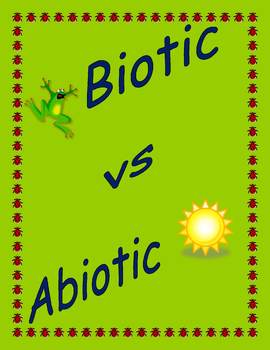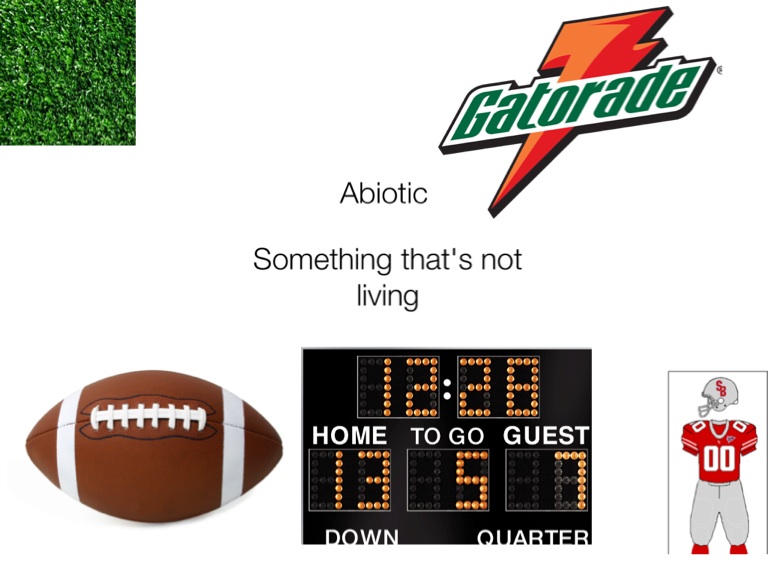Abiotic Vs. Biotic On Flowvella
Biotic And Abiotic Biotic and Abiotic are the twso important factors of Ecosystem which have important characters in shaping the ecosystem. The biotic factors are the living components of an ecosystem and the abiotic factors are non-living chemical and other physical components in the ecosystem. Therefore, both the Biotic and Abiotic factors affect for survival and reproduction. Both components are related to each other, if one component or a factor is removed or changed will affect the whole ecosystem. Among both factors, Abiotic is directly affecting the survival of organisms. Biotic Factors Biotic factors or components are mainly referred to all the living things in the ecosystem.
Their presence or their materials affect the composition of an ecosystem. These materials include organisms, interactions, parts, wastes and also their presence. Factors like disease, predation, and parasitism can also be considered as biotic. All these interactions will make the difference in survival and of each species. Abiotic Factors Abiotic factors or components are mainly referred to all the non-living things with chemical and physical factors. It affects the ability of an organism for reproduction and survival.
These can be acquired from the atmosphere, hydrosphere, and lithosphere. Sunlight, air, moisture minerals, and soil are some examples of abiotic factors. These factors have the significant impact on the survival and reproduction of species in an ecosystem. For instance, without the worthy amount of sunlight some plants are not able to survive and eventually dies, then there will be less food for plant-eating animals and this will leads to the disbalance of the.
Now let’s have a look at the major differences between the Biotic and Abiotic. Difference between Biotic and Abiotic.
The primary difference between biotic and abiotic factors is that biotic factors include the living parts of ecosystems, including plants, microbes and animals, while abiotic factors are environmental components that are nonliving. What are 10 abiotic factors? Search Search. Explore Noodle Open user tools. Explore Noodle. Explore Noodle. Ecosystem Definition & Biotic Factors vs. Abiotic Factors What are 10 abiotic factors? Abby Garcia, Abby- Resident Noodle Expert Apr 24, 2014.


Biotic Abiotic Biotic is referred to all living parts of an ecosystem. Abiotic is referred to all nonliving parts of an ecosystem. Biotic factors depend on abiotic factors to survive for their survival. Abiotic factors don’t rely on the biotic factors for their survival. Directly or indirectly affect the individual species, community, biosphere, the population of species and ecosystem.
Affect the survival of individual species, community, biosphere, the population of species and ecosystem. Obtained directly from the biosphere and are capable of reproduction. Obtained directly from the lithosphere, atmosphere, and hydrosphere. The measurement is often subjective. The measurement is often objective.
Abiotic Vs. Biotic On Flowvellane
Involved in determining the total number of living things, directly or indirectly affecting the organisms in the environment. Involved in determining the total number and different types and of organisms existing in the environment. Have an ability to adapt to changes in the environment. Unable to adapt to changes in the environment. Resources include forests, animals, plants, fungi, bacteria and more. Resources include land, fossil fuels, water and more.
Renewable resource of energy. Non-renewable resource of energy. Few examples of biotic factors are all living things including, animals, plants, fungi, bacteria, etc.
Few examples of abiotic factors are sunlight, air, climate, temperature, moisture minerals, soil and more. Stay tuned with BYJU”S to learn more about the Biotic and Abiotic are the factors of Ecosystem.
Differences — Similarities — Abiotic versus Biotic comparison chart Abiotic Biotic Introduction In ecology and biology, abiotic components are non-living chemical and physical factors in the environment which affect ecosystems. Biotic describes a living component of an ecosystem; for example organisms, such as plants and animals. Examples Water, light, wind, soil, humidity, minerals, gases. All living things — — plants, animals, fungi,.
Factors Affect the ability of organisms to survive, reproduce; help determine types and numbers of organisms able to exist in environment; limiting factors restrict growth. Living things that directly or indirectly affect organisms in environment; organisms, interactions, waste; parasitism, disease, predation. Affects Individual of a species, population, community, ecosystem, biome, biosphere. Individual of a species, population, community, ecosystem, biome, biosphere. What are biotic and abiotic factors? Biotic components are living organisms in an ecosystem.
A biotic factor is a living organism that affects another organism in its ecosystem. Examples include plants and animals that the organism consumes as food, and animals that consume the organism.
Abiotic Vs Biotic On Flowvella Download
The following video covers the biotic and abiotic factors that influence most ecosystems, and introduces key vocabulary relevant to ecology: This is a that covers the definition and examples of biotic and abiotic factors in an ecosystem: Relevance The scope of abiotic and biotic factors spans across the entire biosphere, or global sum of all ecosystems. Such factors can have relevance for an individual within a species, its community or an entire population. For instance, disease is a biotic factor the survival of an individual and its community. Is an abiotic factor with the same relevance. Some factors have greater relevance for an entire ecosystem. Abiotic and biotic factors combine to create a system or, more precisely, an ecosystem, meaning a community of living and nonliving things considered as a unit.
In this case, abiotic factors span as far as the pH of the soil and water, types of nutrients available and even the length of the day. Biotic factors such as the presence of or self-nourishing organisms such as, and the diversity of consumers also affect an entire ecosystem. Influencing Factors Abiotic factors affect the ability of organisms to survive and reproduce. Abiotic limiting factors restrict the growth of populations. They help determine the types and numbers of organisms able to exist within an.
Biotic factors are living things that directly or indirectly affect organisms within an environment. This includes the organisms themselves, other organisms, interactions between living organisms and even their waste. Other biotic factors include parasitism, disease, and predation (the act of one animal eating another).
Interaction Examples The significance of abiotic and biotic factors comes in their interaction with each other. For a community or an ecosystem to survive, the correct interactions need to be in place.
A simple example would be of abiotic interaction in plants. Water, sunlight and carbon dioxide are necessary for plants to grow. The biotic interaction is that plants use water, sunlight and carbon dioxide to create their own nourishment through a process called photosynthesis. On a larger scale, abiotic interactions refer to patterns such as climate and seasonality. Factors such as temperature, humidity and the presence or absence of seasons affect the ecosystem. For instance, some ecosystems experience cold winters with a lot of snow.
An animal such as a fox within this ecosystem adapts to these abiotic factors by growing a thick, -colored coat in the winter. Decomposers such as bacteria and fungi are examples of biotic interactions on such a scale. Decomposers function by breaking down dead organisms. This process returns the basic components of the organisms to the soil, allowing them to be reused within that ecosystem. References.